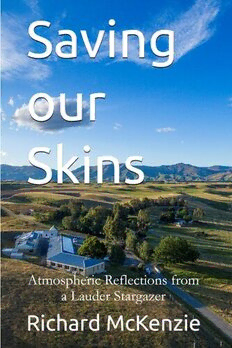
Saving our skins : atmospheric reflections from a Lauder stargazer PDF
Preview Saving our skins : atmospheric reflections from a Lauder stargazer
SAVING OUR SKINS Saving our Skins Atmospheric Reflections from a Lauder Stargazer Richard McKenzie Tophouse Ltd Copyright © 2020 Richard McKenzie All rights reserved. ISBN: 978-0-473-53730-2 Also published as ISBN 979863473987 (paperback – Amazon b/w) ISBN 9798654069511 (paperback – Amazon colour) ISBN 978-0-473-53329-8 (paperback, Tophouse Ltd) Jets and Lies DEDICATION I dedicate “Saving our Skins” to our son David. His life was cut short before he had a chance to flower fully, but he unknowingly inspired the work. Memorial at Dunstan High School, Alexandra. . iii Saving our Skins Cover image. Long shadows near sunset at NIWA’s Lauder Atmospheric Research Station, photographed on December 14, 2015 from a drone looking west towards Thomsons Gorge in the Dunstan Range. Photo credit: Dave Allen, NIWA. CONTENTS Foreword i Note from the Author iii 1 Jets and Lies 1 2 Sun, Earth and Radio 10 3 Changing of the Guard 16 4 Measuring Ozone 24 5 Nights to Remember 32 6 Lauder Stargazers 39 7 The Dreaming Spires 47 8 Zeeman Modulation and More 54 9 The Ozone Hole 64 10 Finding the Culprit 71 11 Why Worry? 79 12 UV and More 87 13 Dark Clouds & Silver Linings 95 14 Fire and Water 104 15 The Things We Did 110 16 Balancing Acts 121 17 The Montreal Protocol 131 18 Flies in the Ointment 141 19 Questions and Answers 147 20 Changing Faces 155 21 A Safer World? 162 22 Going Viral 169 23 Back to the Beginning 177 Epilogue 181 Comings and Goings 185 The Back-Story 199 Glossary 210 Acknowledgements 211 Bibliography 213 About the Author 221 SAVING OUR SKINS Foreword “Saving our Skins” is an insider’s account of the most successful international environmental action ever undertaken: the Montreal Protocol on Protection of the Ozone Layer. The author’s career in ozone research began years before the discovery of the Antarctic ozone hole and continues to the present day. He brings a first-hand experience through his research. It’s the story of the part he and his colleagues played in bringing about the success of the Montreal Protocol. But its broader than just the ozone story. It’s played out against the backdrop of the ever-increasing threat from climate change and its interactions with ozone. “Saving our Skins” summarises the contribution to humanity of atmospheric research at Lauder over the last 40 years. The title plays on the dual problems of ozone depletion - which would have led to dramatic increases in UV - and skin cancer; and climate change - where drastic actions are still needed to save our collective bacon. The Earth’s atmosphere is a thin and fragile skin. If the planet was reduced to the size of a basketball, the scaled-down atmosphere would be just 0.3 millimetres thick.1 Much less than the depth of the dimples on the basketball. It’s no wonder that skin is proving to be so fragile in the face of mankind’s offences against it. Finally, the initials of the title call out an SOS for urgent action on climate change. The author brings an authoritative account of the science; but conveyed in language accessible to the non-specialist. The science story is intertwined with a personal life story in an isolated rural community contrasted with life at Oxford University and plying the globe for conferences, meetings and lectures - over a career in atmospheric science that spans the tumults of the last 4 decades. 1 The Earth’s radius is 6400 km, and the equivalent depth of the atmosphere is 8 km. For a basketball of diameter 24 cm, the corresponding thickness would be 24 cm x 8/6400 = 0.03 cm = 0.3 mm. i SAVING OUR SKINS Note from the Author This is a personal view of critical environmental issues interspersed with some lighter (and darker) personal moments. My aim has been to accurately convey the science, while at the same time making it accessible to the non- specialist. I’ve tried to avoid technical terms and scientific jargon. Where that’s not possible, I’ve attempted to define them in simple layman’s language, with footnotes for more specialised information. My field of atmospheric science is littered with TLAs (Three Letter Acronyms) and TFLAs (Three-or-Four Letter Abbreviations), so I’ve also included a glossary to help guide you through that morass. I’ve resisted the urge to include references, as that would create too much of a distraction. Most quantitative statements are backed up in my publications, which are listed in the bibliography. Full text to those can be found by searching Google Scholar with appropriate keywords. Hot links have also been included for- on-line versions. I expect that different readers will gain different insights. If you’re less interested in the underlying ozone science, you may still find interest in its surrounding history, or even my personal journey through that history. Some may even find it useful as a simplified guide to understanding the science behind current atmospheric research issues. Others may find it a cure to insomnia. . iii
